Analysis of the Effects of Arc Volt–Ampere Characteristics on Different Loads and Detection Methods of Series Arc Faults
Abstract
:1. Introduction
2. Volt–Ampere Characteristics of an Arc
3. Effects of Arc Volt–Ampere Characteristics on Different Types of Loads
3.1. Purely Resistive Load
- i is in phase with u;
- The shoulders are obvious;
- There will be a sudden change when i increases from zero, and i will suddenly increase from zero to a certain value, which is mainly determined based on Uz and RL;
- While i decreases to zero, it has an approximately sinusoidal curve.
3.2. Diode Rectifier with Capacitor Filter
- Pulses will occur multiple times within a half cycle, and because the diodes are likely to conduct as the voltage decreases, forming a stable line current i, there are more pulses during the period of voltage increase than during the period of decrease;
- The waveform of i also has random characteristics in different half cycles.
3.3. Inductive Load
- The phase of u is approximately 90° ahead of i;
- The shoulders are not obvious;
- There is no sudden change in current, and i is similar to a sinusoidal wave.
- The phase of u is ahead of i;
- There are obvious shoulders;
- There may be several pulse currents in the shoulders.
4. Series Arc Fault Detection
4.1. AFDD Hardware Circuit Design
4.2. Series Arc Fault Detection Method
4.2.1. Detection of Shoulder Time
4.2.2. Detection of Pulse Current
4.2.3. Detection of Randomness
5. Test Verification and Analysis
6. Conclusions
Author Contributions
Funding
Conflicts of Interest
References
- Underwriters Laboratories Inc. UL Standard for Arc-Fault Circuit-Interrupters, 2nd ed.; Underwriters Laboratories Inc.: New York, NY, USA, 2011. [Google Scholar]
- General Administration of Quality Supervision, Inspection and Quarantine of the People’s Republic of China; Standardization Administration of the People’s Republic of China. Electrical Fire Monitoring System–Part 4: Arcing Fault Detectors (GB14287.4-2014); Standards Press of China: Beijing, China, 2014.
- George, D.G.; Gary, W.S. The arc-fault circuit interrupter: An emerging product. IEEE Trans. Ind. Appl. 1998, 34, 928–933. [Google Scholar]
- Seong, W.K.; Eun, D.L.; Dong, H.J.; Seung, W.S. A physical and logical security framework for multilevel AFCI systems in smart grid. IEEE Trans. Smart Grid. 2011, 2, 496–506. [Google Scholar]
- General Administration of Quality Supervision, Inspection and Quarantine of the People’s Republic of China; Standardization Administration of the People’s Republic of China. General Requirements for Arc Fault Detection Devices (AFDD) (GB/T 31143); Standards Press of China: Beijing, China, 2014.
- Jinmi, L.; Patrick, S.; Serge, W.; Etienne, T.; Patrice, J. Arc Fault Detection Based on Temporal Analysis. In Proceedings of the IEEE Conference on Electrical Contacts, New Orleans, LA, USA, 12–15 October 2014. [Google Scholar]
- Pellon, C.V.; Rabiner, M.D.; Nicolls, C.A.; Zanelli, R.; Fontaine, L.; Edmunds, L.; Parker, M.; Kawate, K.W.; Mayer, R.D.; Lavado, M.J.; et al. Apparatus and Method for Detecting Arc Faults. European Patent 1 638 181 A2, 22 March 2006. [Google Scholar]
- Carlos, E.R. Arc fault detection and discrimination methods. In Proceedings of the Electrical Contacts-2007 the 53rd IEEE Holm Conference on Electrical Contacts, Pittsburgh, PA, USA, 16–19 September 2007. [Google Scholar]
- Etienne, T.; Jinmi, L.; Patrick, S.; Yves, B. Series arcing detection by algebraic derivative of the current. Electr. Power Syst. Res. 2015, 119, 91–99. [Google Scholar]
- Giovanni, A.; Antonio, C.; Valentina, C.; Dario, D.C.; Salvatore, N.; Giovanni, T. Arc fault detection method based on CZT low-frequency harmonic current analysis. IEEE Trans. Instrum. Meas. 2017, 66, 888–896. [Google Scholar]
- Joshua, E.S.; Shane, P.; Yongbin, S.; Sanjay, E.S. Real-time Deep Neural Networks for internet-enabled arc-fault detection. Eng. Appl. Artif. Intell. 2018, 74, 35–42. [Google Scholar]
- Nedzad, H.; Miomir, K.; Zoran, R. Detection of series arcing in low voltage electrical installations. Eur. Trans. Electr. Power. 2009, 19, 423–432. [Google Scholar]
- Yang, K.; Zhang, R.; Yang, J.; Liu, C.; Chen, S.; Zhang, F. A novel arc fault detector for early detection of electrical fires. Sensors 2016, 16, 500. [Google Scholar] [CrossRef]
- Yang, K.; Zhang, R.; Chen, S.; Zhang, F.; Yang, J.; Zhang, X. Series Arc Fault Detection Algorithm Based on Autoregressive Bispectrum Analysis. Algorithms 2015, 8, 929–950. [Google Scholar] [CrossRef] [Green Version]
- Cheng, H.; Chen, X.J.; Liu, F.Y.; Wang, C. Series arc fault detection and implementation based on the short-time Fourier transform. In Proceedings of the 2010 Asia-Pacific Power and Energy Engineering Conference (APPEEC), Chengdu, China, 28–31 March 2010. [Google Scholar]
- Qi, P.; Jovanovic, S.; Lezama, J.; Schweitzer, P. Discrete wavelet transform optimal parameters estimation for arc fault detection in low-voltage residential power networks. Electr. Power Syst. Res. 2017, 143, 130–139. [Google Scholar] [CrossRef]
- Ji, H.K.; Wang, G.; Kim, W.H.; Kil, G.S. Optimal Design of a Band Pass Filter and an Algorithm for Series Arc Detection. Energies 2018, 11, 992. [Google Scholar] [CrossRef]
- Lu, Q.W.; Wang, T.; Li, Z.R.; Wang, C. Detection method of series arcing fault based on wavelet transform and singular value decomposition. Trans. Chin. Electr. Soc. 2017, 32, 208–217. (In Chinese) [Google Scholar]
- Zeng, K.; Xing, L.D.; Zhang, Y.J.; Wang, L. Characteristics analysis of AC arc fault in time and frequency domain. In Proceedings of the 2017 Prognostics and System Health Management Conference (PHM-Harbin), Harbin, China, 9–12 July 2017; pp. 288–292. [Google Scholar]
- Liu, Y.W.; Wu, C.J.; Wang, Y.C. Detection of serial arc fault on low-voltage indoor power lines by using radial basis function neural network. Electr. Power Energy Syst. Res. 2016, 83, 149–157. [Google Scholar] [CrossRef]
- Wu, C.J.; Liu, Y.W. Smart detection technology of serial arc fault on low-voltage indoor power lines. Int. J. Electr. Power Energy Syst. 2015, 69, 391–398. [Google Scholar] [CrossRef]
- Kostyantyn, K.; Bei, G.; Joel, A. A low-cost power-quality meter with series arc-fault detection capability for smart grid. IEEE Trans. Power Deliv. 2013, 28, 1584–1591. [Google Scholar]
- Liu, W.J.; Zhang, X.B.; Ji, R.P.; Dong, Y.J.; Li, W.L. Arc fault detection for AC SSPC in MEA with HHT and ANN. In Proceedings of the IEEE International Conference on Aircraft Utility Systems (AUS), Beijing, China, 10–12 October 2016. [Google Scholar]
- Alireza, K.; Steffen, F.; Dirk, U.; Sergey, G.; Ralf, P.M. Electrical arc model based on physical parameters and power calculation. IEEE Trans. Plasma Sci. 2015, 43, 2721–2729. [Google Scholar]
- Kumar, V.V.; Thomas, M.J.; Naidu, M.S. Influence of Switching Conditions on the VFTO Magnitudes in a GIS. IEEE Trans. Power Del. 2001, 16, 539–544. [Google Scholar] [CrossRef]
- Povh, D.; Schmitt, H.; Valcker, O.; Wutzmann, R. Modelling and Analysis Guidelines for Very Fast Transients. IEEE Trans. Power Deliv. 1996, 11, 2028–2035. [Google Scholar] [CrossRef]
- Lin, X.; Wang, N.; Xu, J.Y. Calculation and analysis of very fast transient over-voltage characteristic on the condition of dynamic arcing model. Proc. CSEE 2012, 32, 157–164. (In Chinese) [Google Scholar]
- Parise, G.; Martirano, L.; Laurini, M. Simplified arc-fault model: The reduction factor of the arc current. IEEE Trans. Ind. Appl. 2013, 49, 1703–1710. [Google Scholar] [CrossRef]
- Krishna, M.; Ramesh, O. Conducted EMI mitigation techniques for switch-mode power converters: A survey. IEEE Trans. Power Electron. 2010, 25, 2344–2356. [Google Scholar]
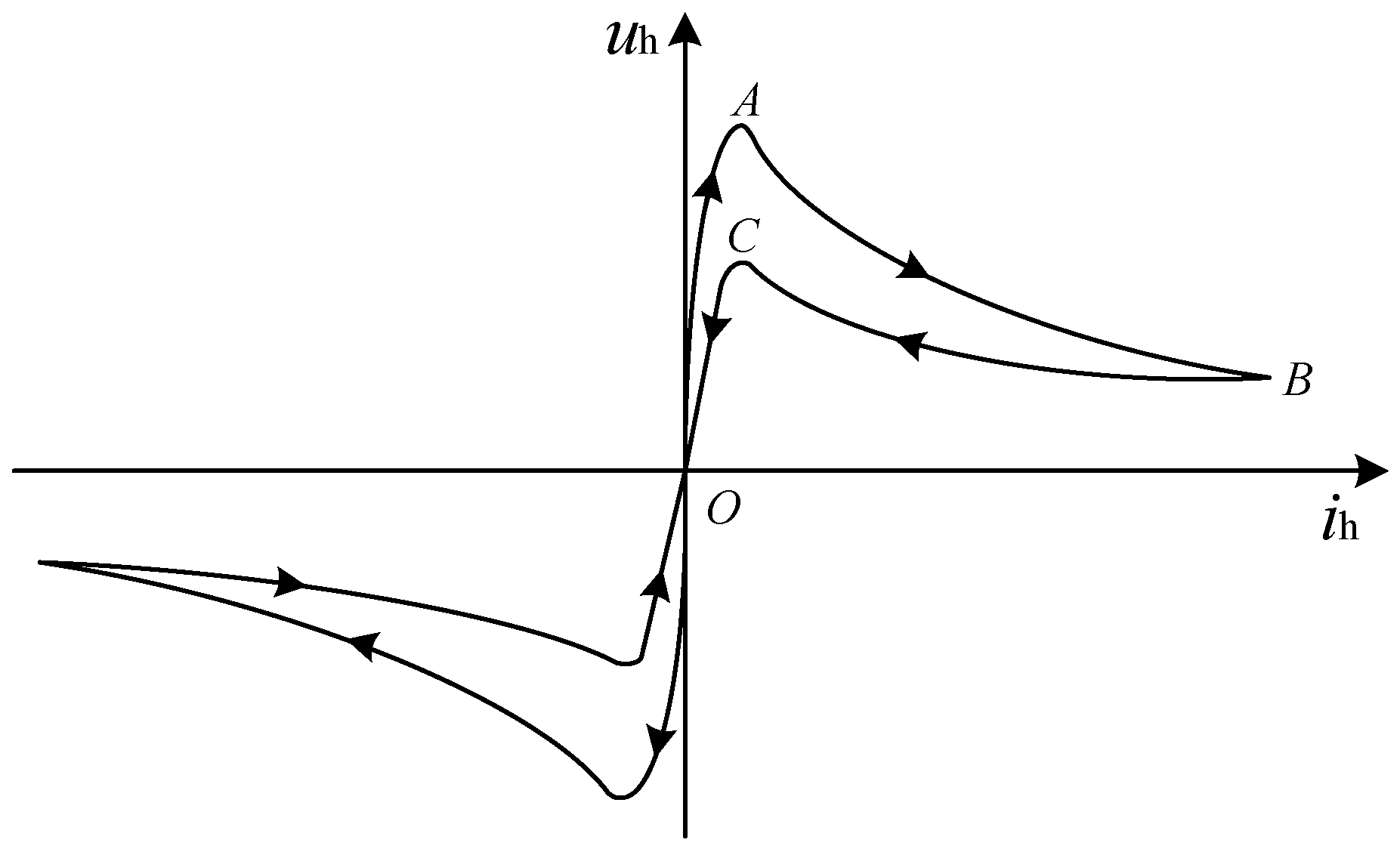
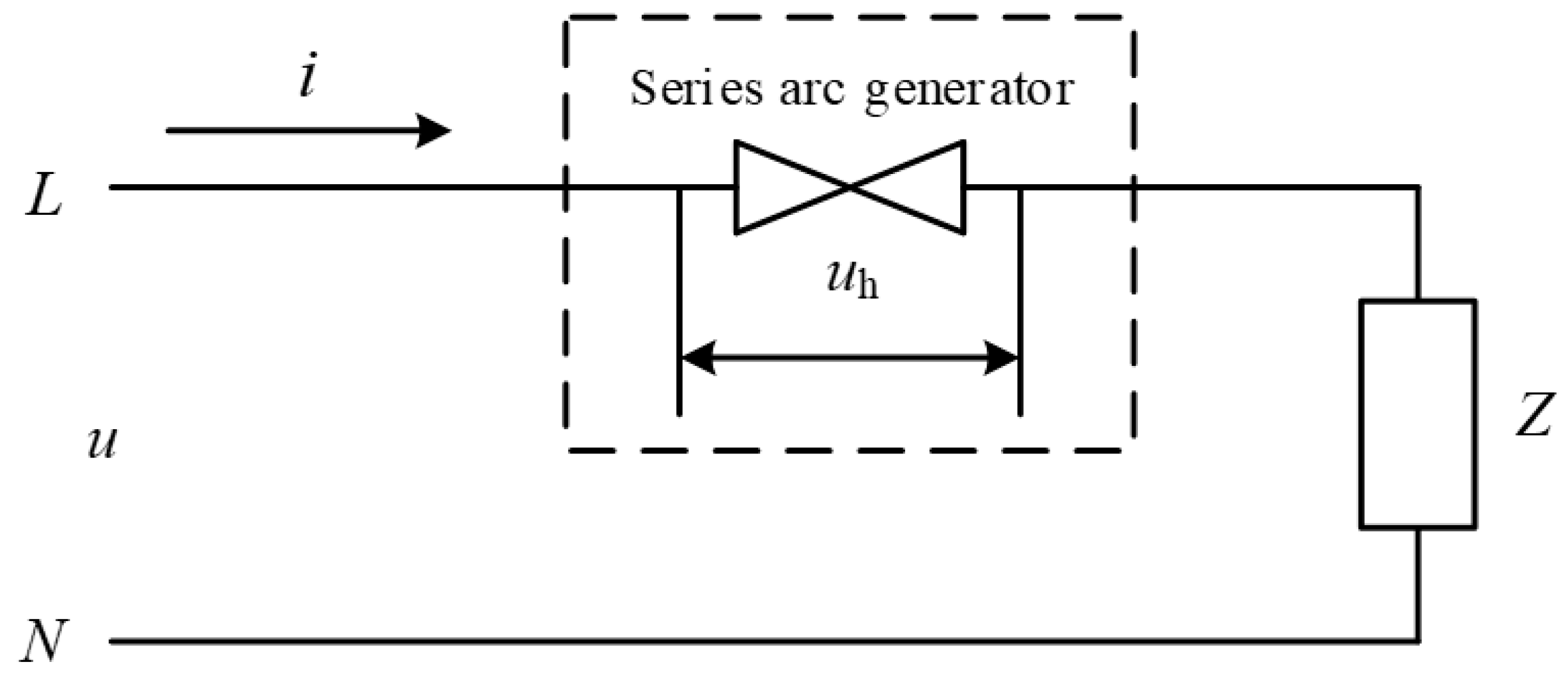
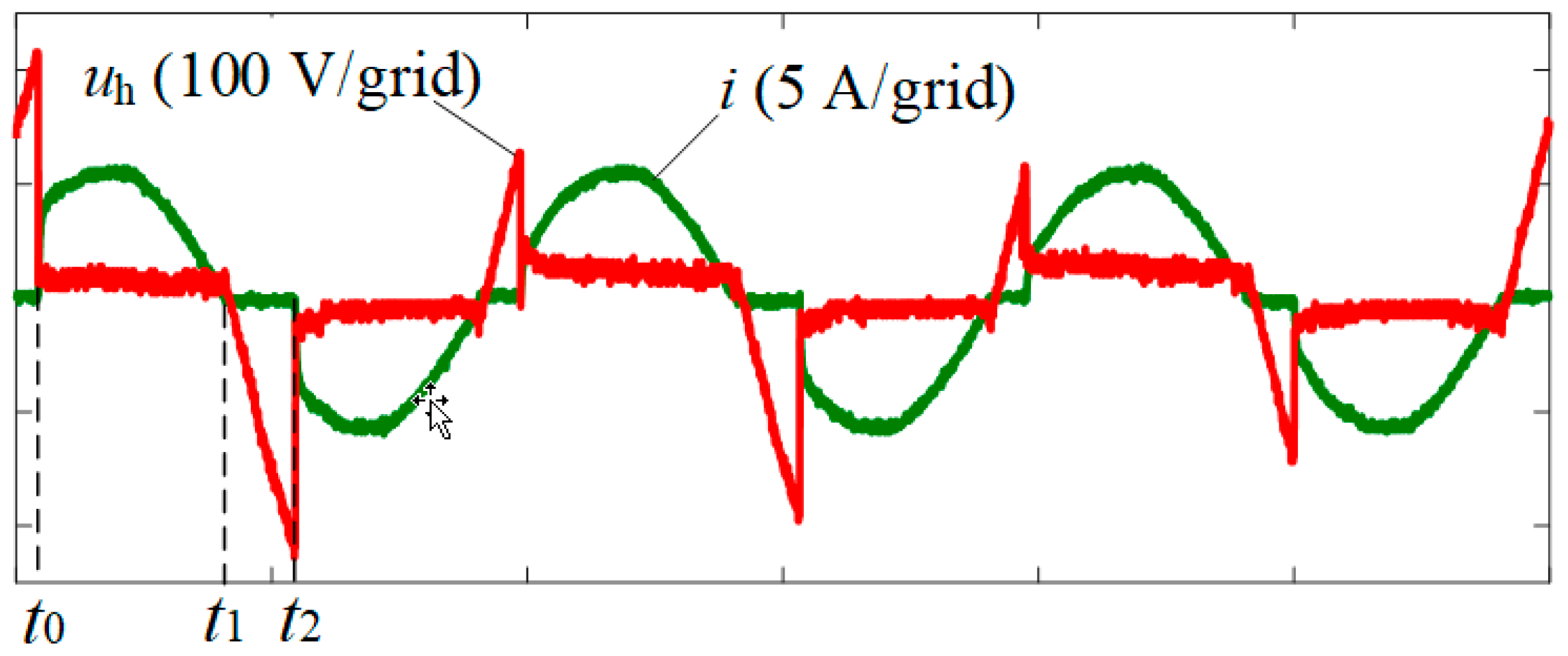

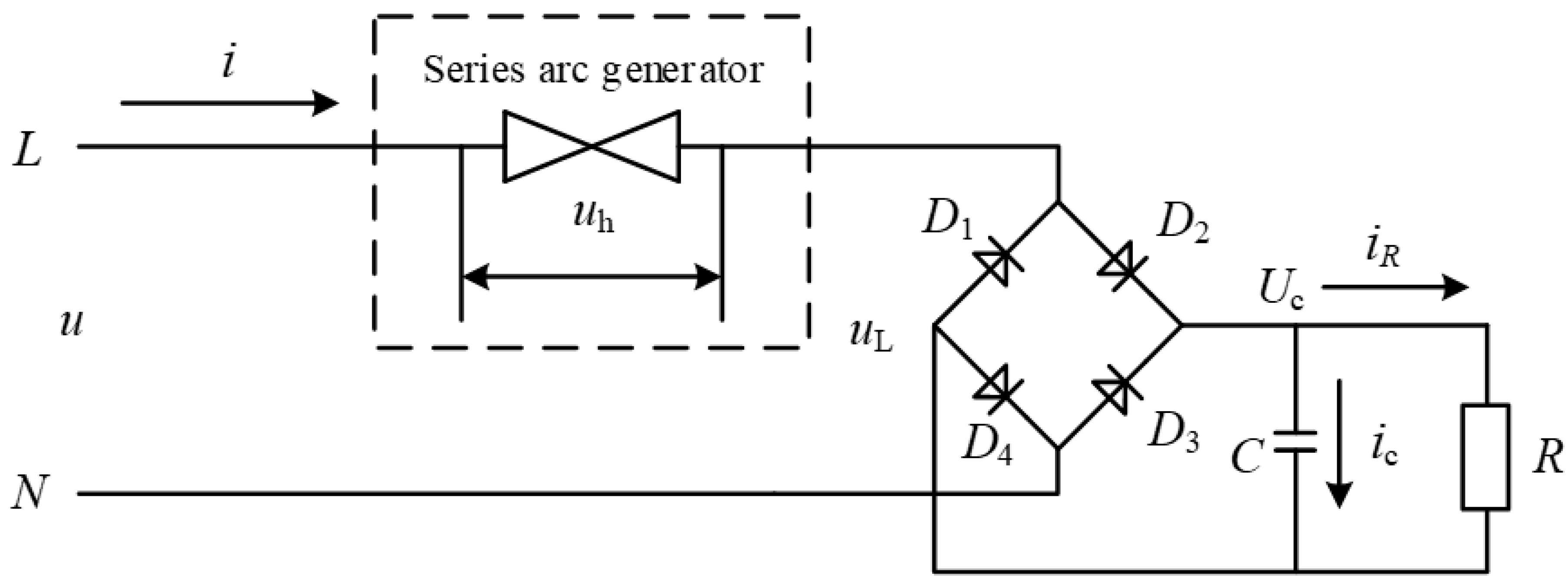

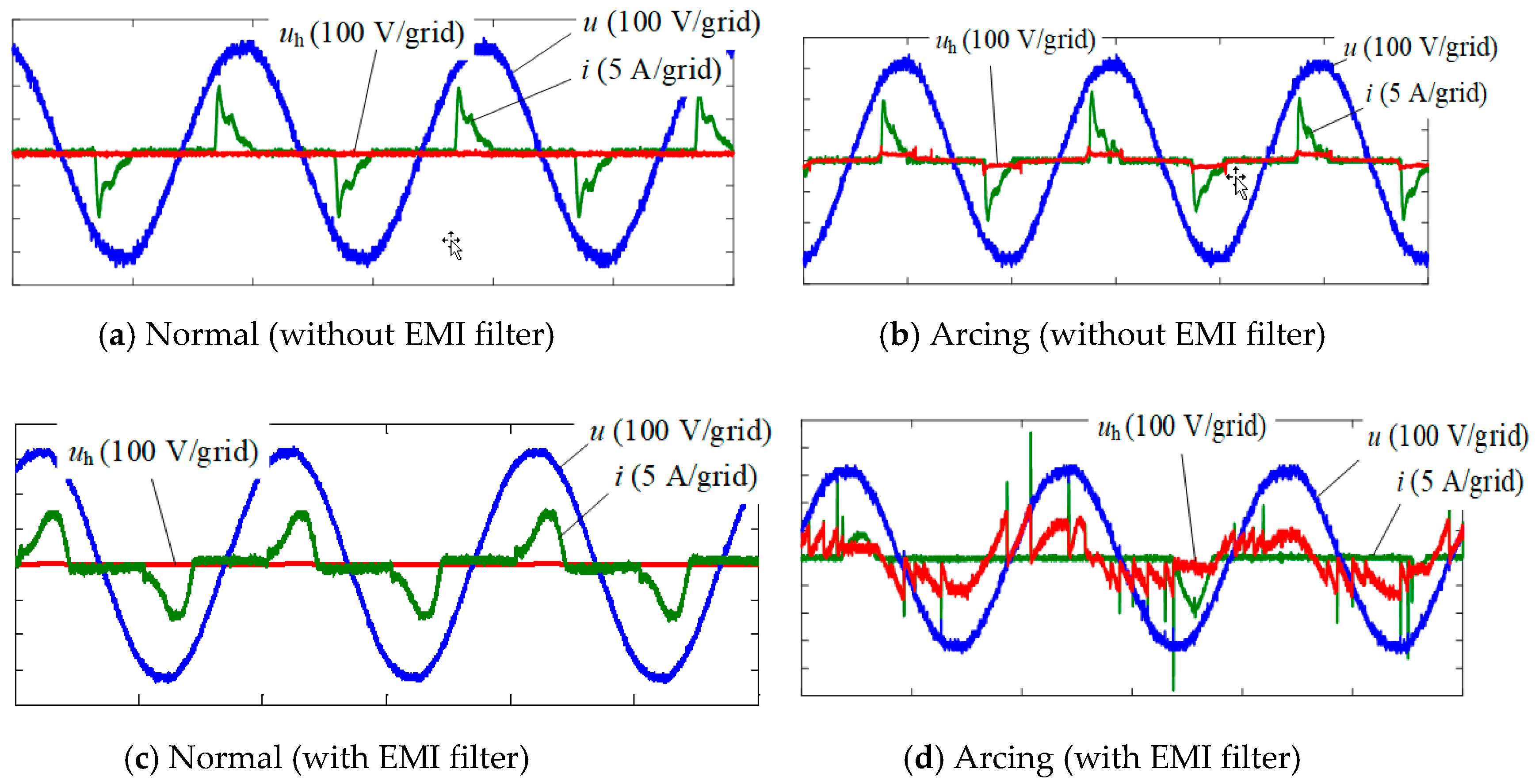

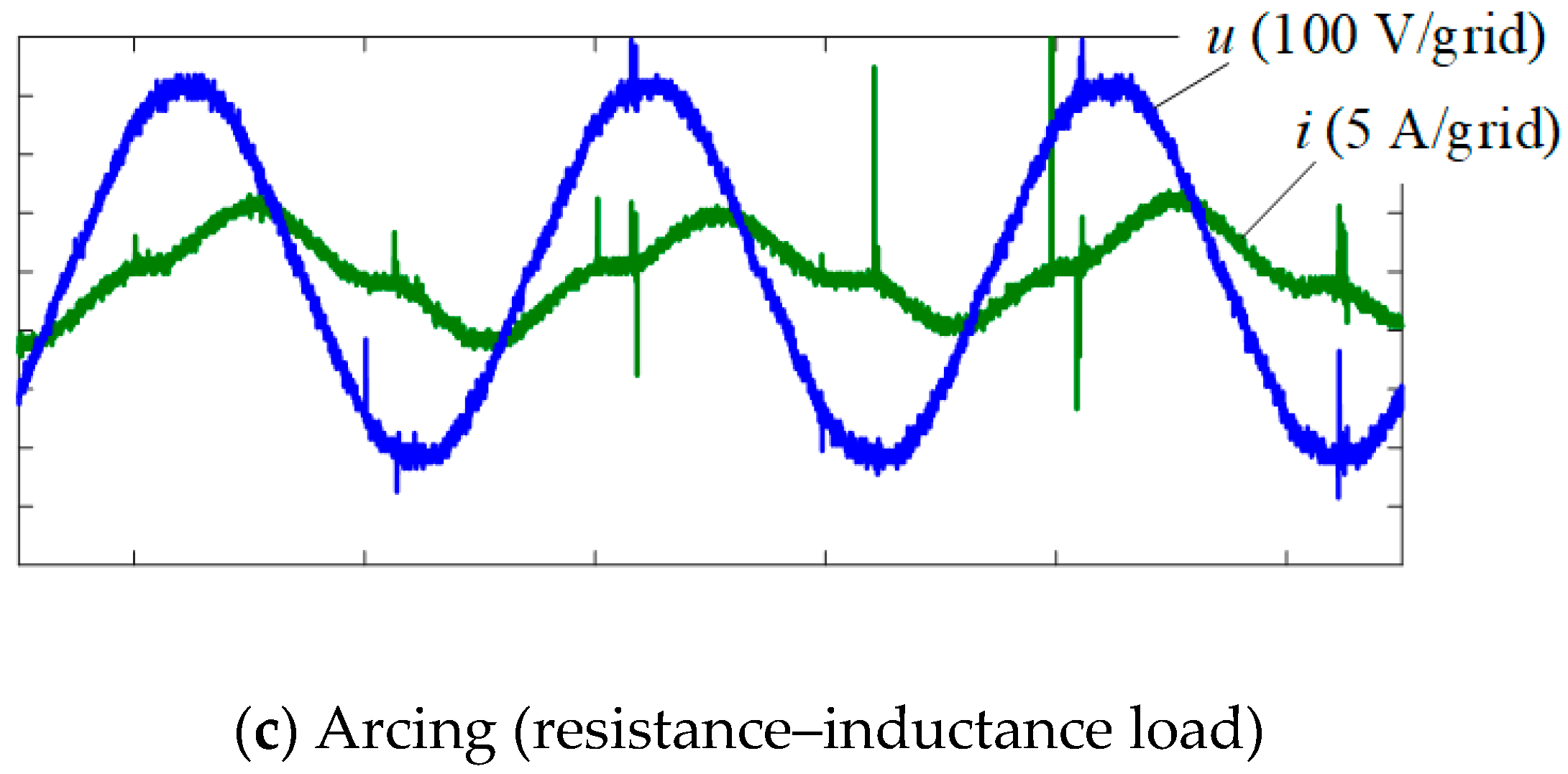
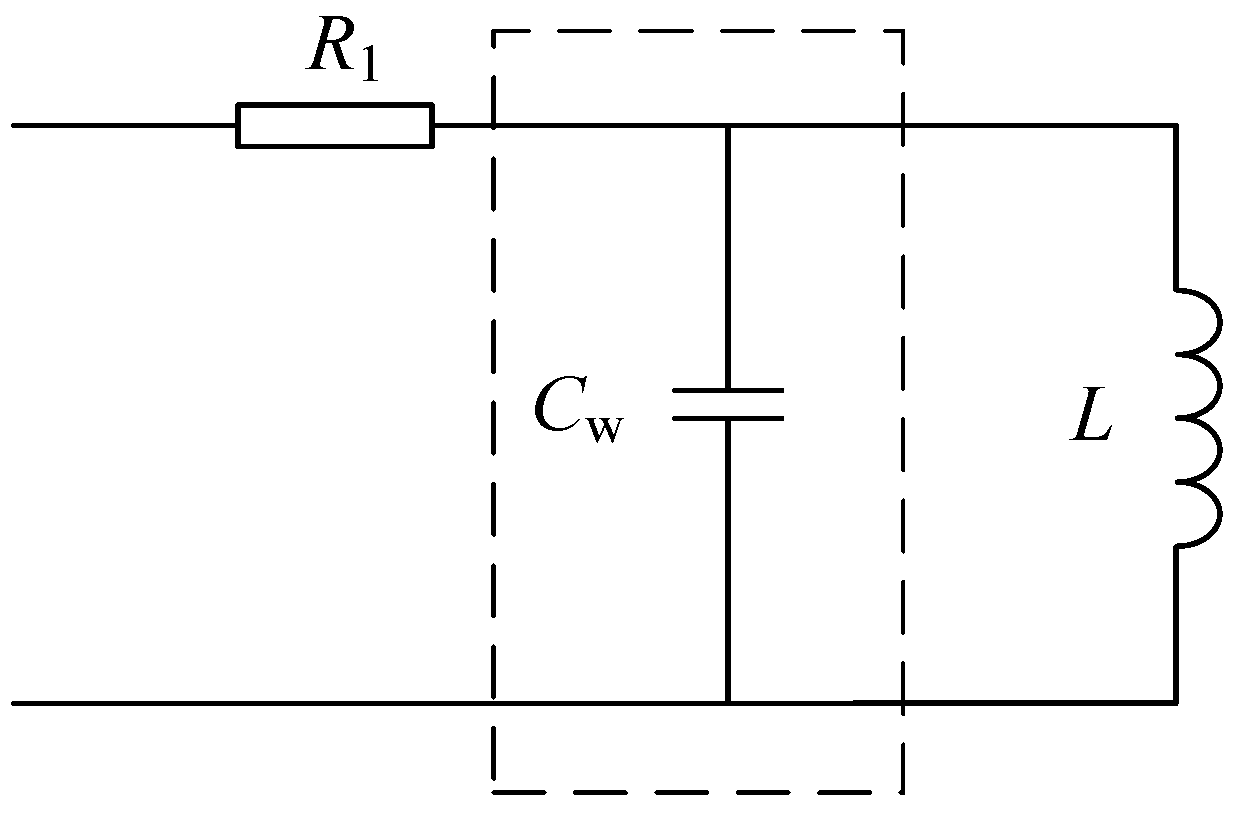
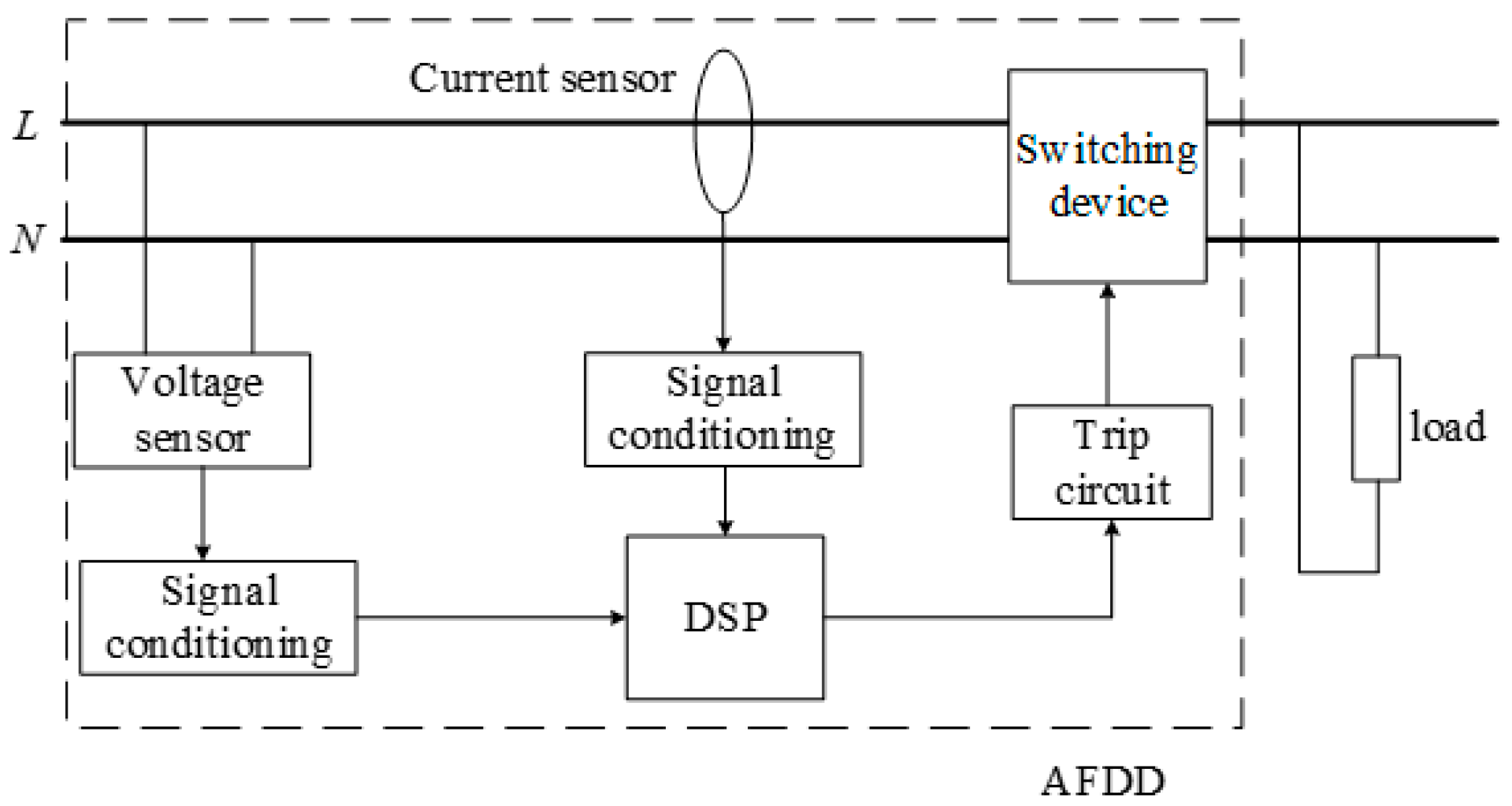
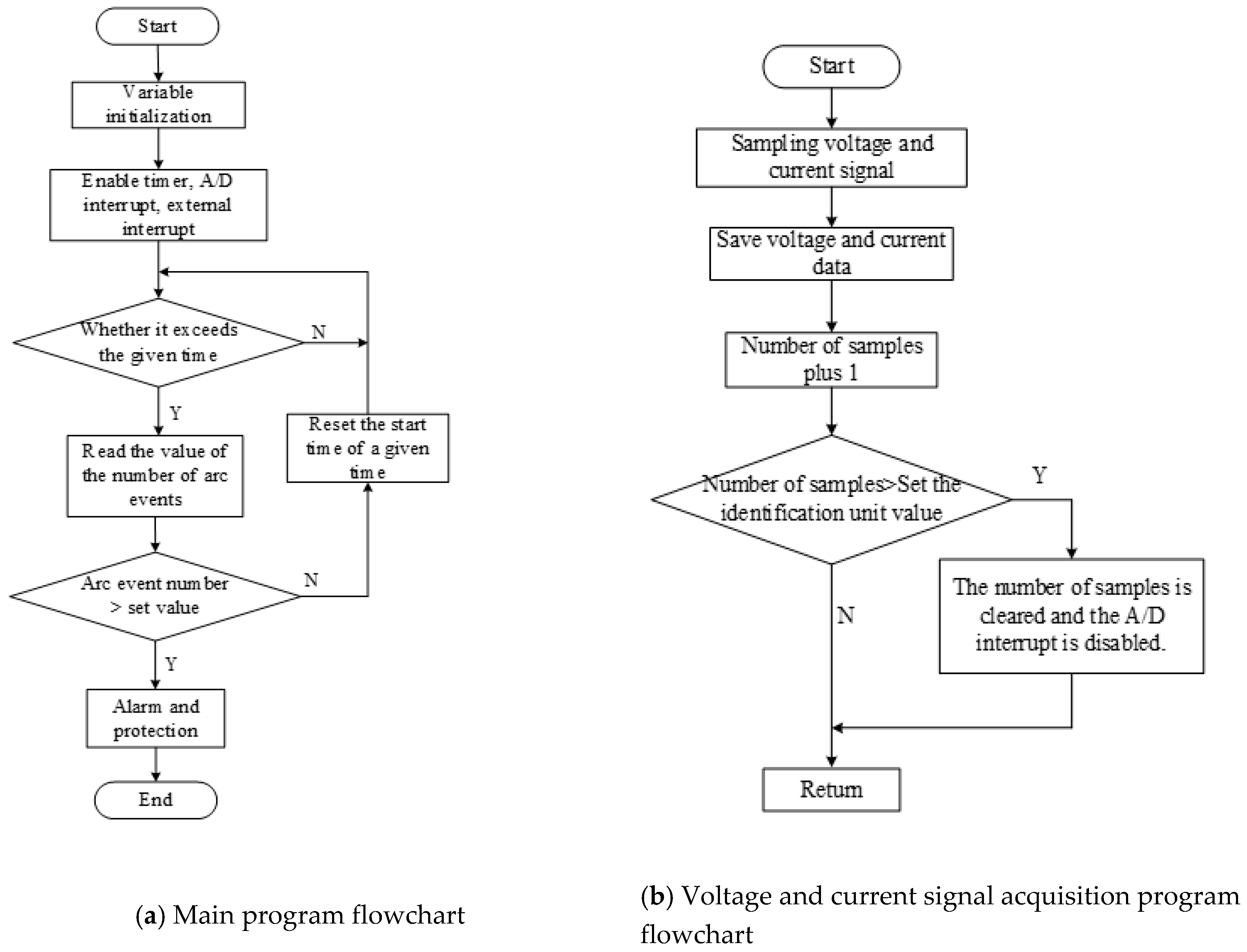

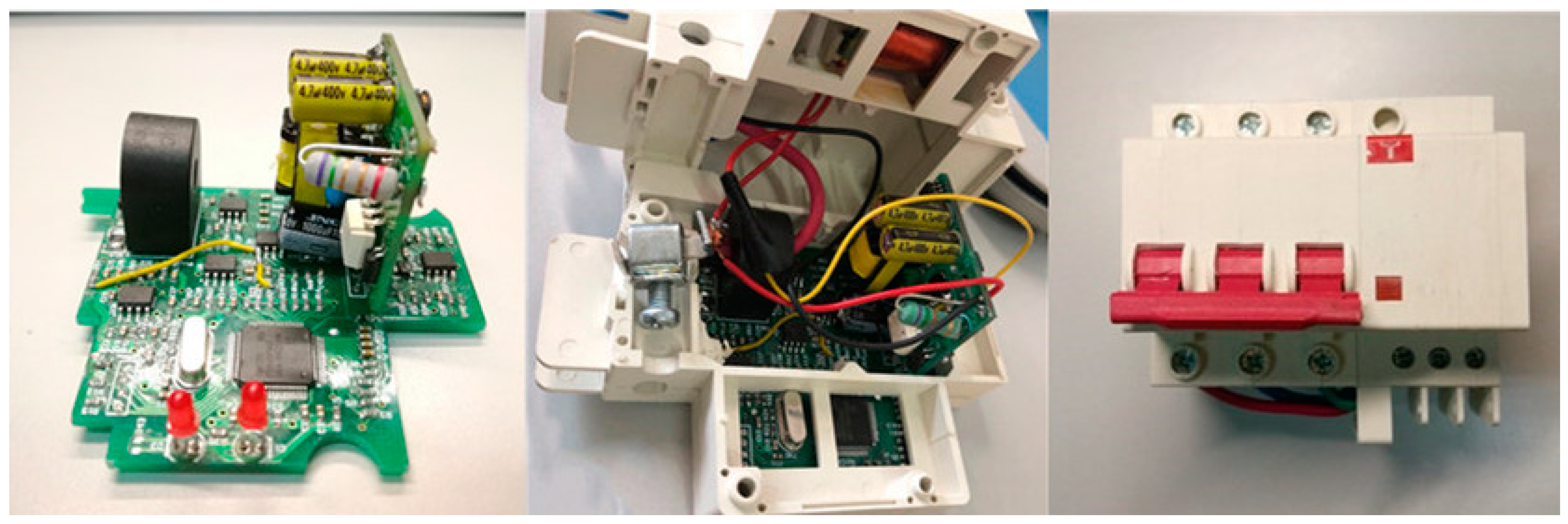
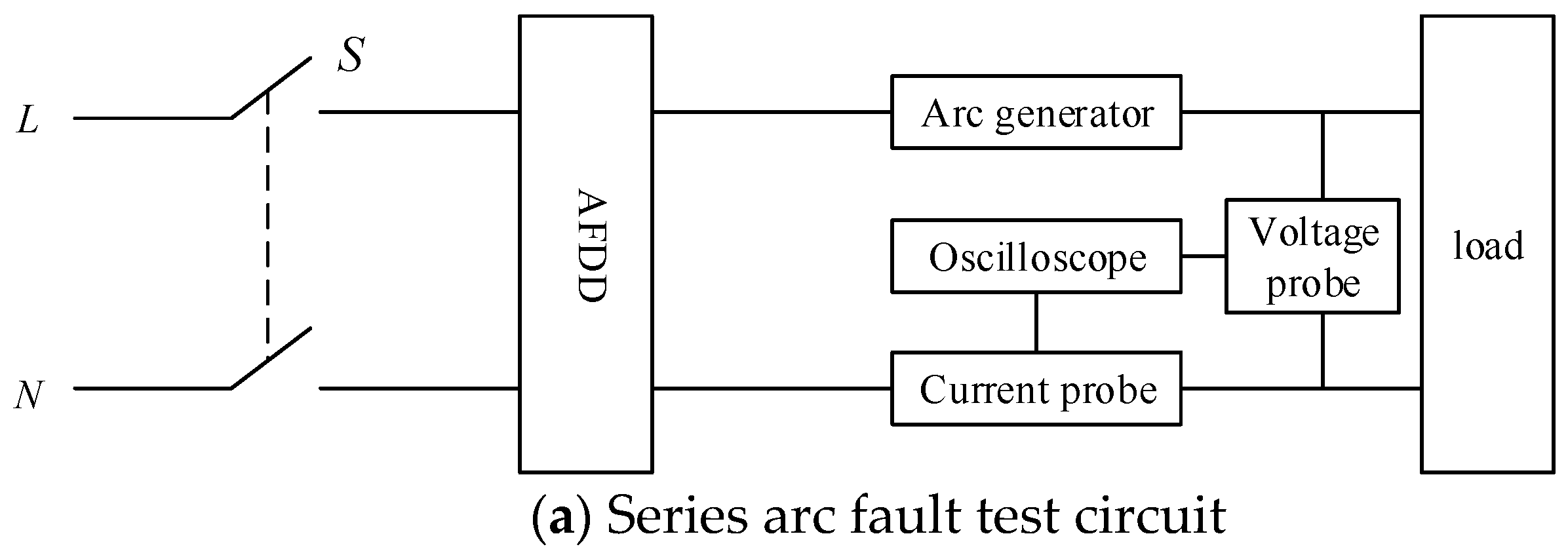
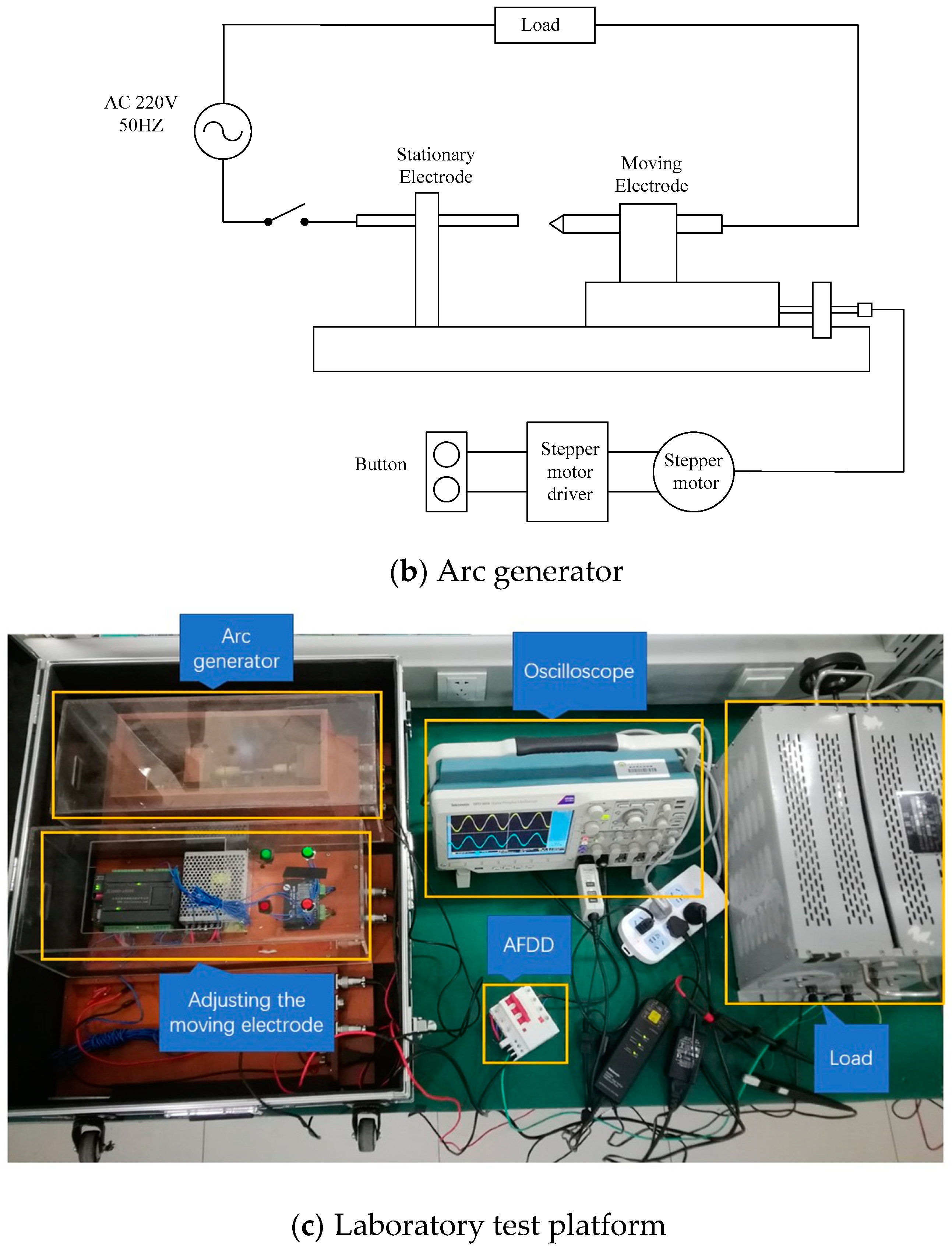
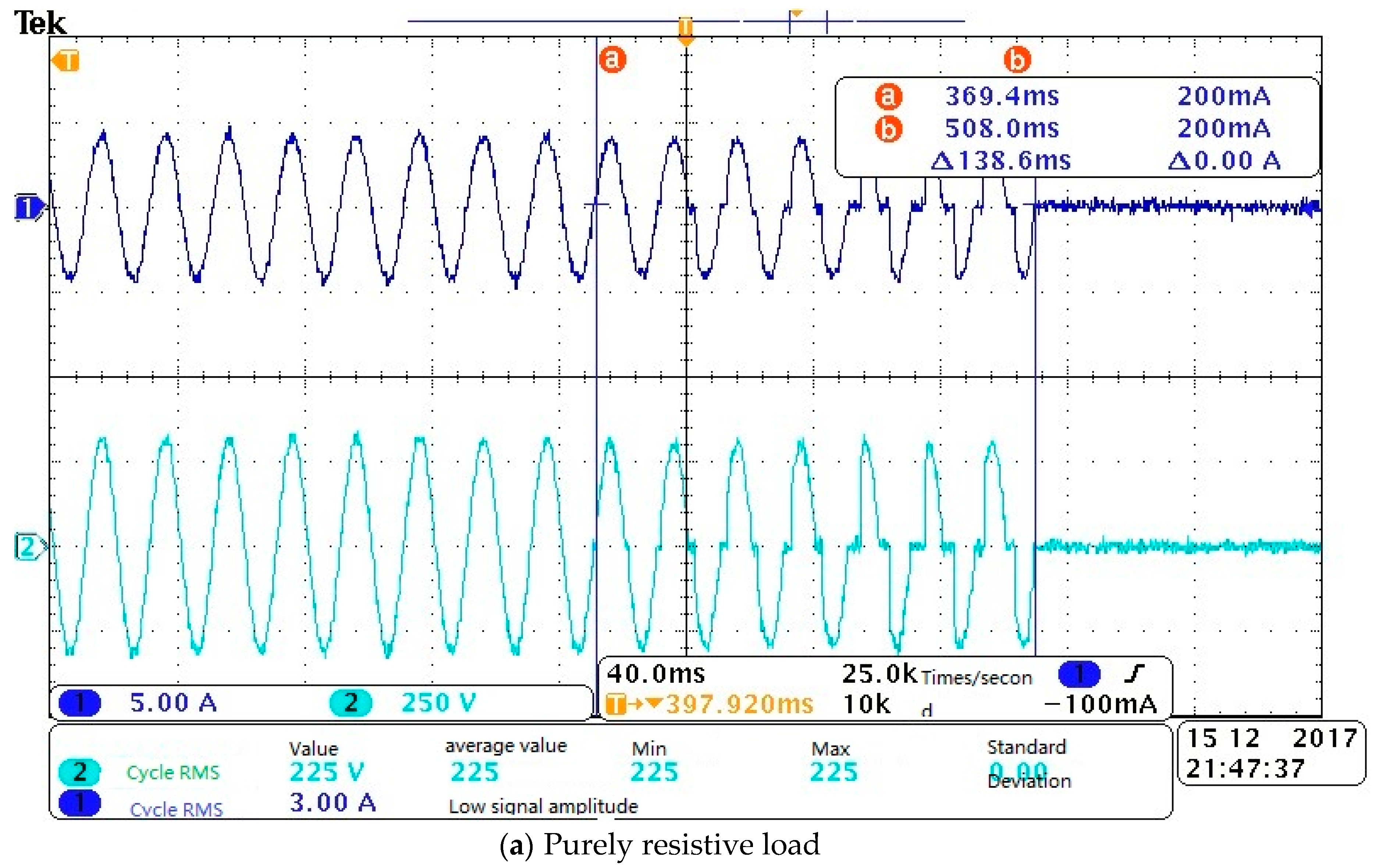
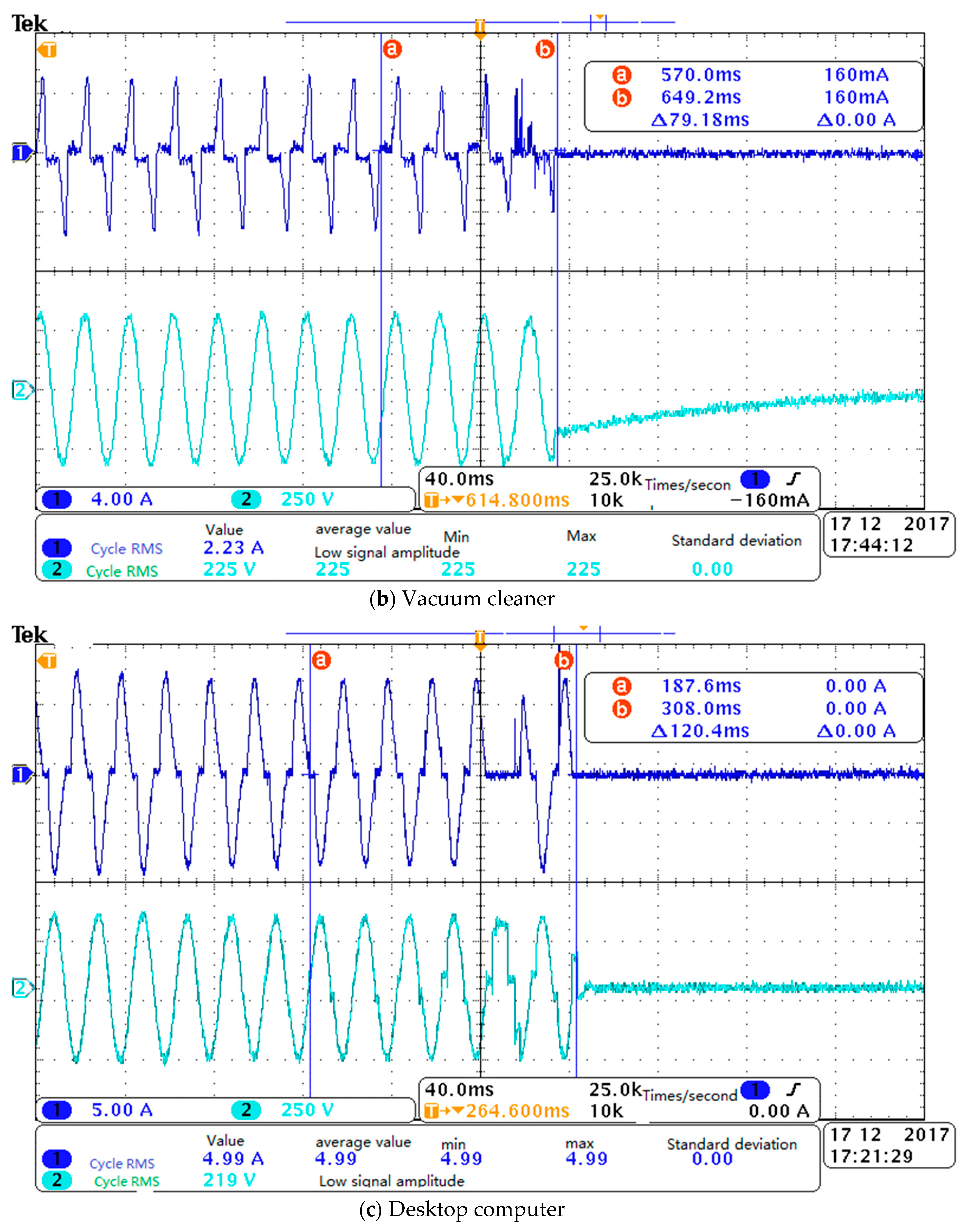
| Load | Power (W) | Breaking Time (s) | Mean (s) | Standard Deviation (s) |
|---|---|---|---|---|
| 660 | 0.138–0.680 | 0.380 | 0.143 | |
| Adjustable resistor | 1320 2860 4400 8800 | 0.189–0.368 0.100–0.129 0.130–0.143 0.103–0.114 | 0.294 0.116 0.135 0.108 | 0.045 0.007 0.003 0.003 |
| Vacuum cleaner | 1100 | 0.110–0.289 | 0.187 | 0.042 |
| Fluorescent lamp | 350 | 0.069–0.181 | 0.125 | 0.021 |
| Halogen lamp | 565 | 0.078–0.289 | 0.173 | 0.044 |
| Inverter air conditioner | 2225 | 0.098–0.207 | 0.142 | 0.021 |
| Hand drill | 600 | 0.275–0.425 | 0.347 | 0.040 |
| Dimming light | 600 | 0.214–0.568 | 0.384 | 0.087 |
| Desktop computer | 500 | 0.071–0.162 | 0.113 | 0.020 |
| Vacuum cleaner and adjustable resistor | 1700 | 0.134–0.193 | 0.151 | 0.012 |
| Inverter air conditioner and dimming light | 2825 | 0.113–0.202 | 0.142 | 0.016 |
| Fluorescent, halogen, hand drill, and desktop computer | 2015 | 0.068–0.173 | 0.112 | 0.019 |
© 2019 by the authors. Licensee MDPI, Basel, Switzerland. This article is an open access article distributed under the terms and conditions of the Creative Commons Attribution (CC BY) license (http://creativecommons.org/licenses/by/4.0/).
Share and Cite
Lu, Q.; Ye, Z.; Zhang, Y.; Wang, T.; Gao, Z. Analysis of the Effects of Arc Volt–Ampere Characteristics on Different Loads and Detection Methods of Series Arc Faults. Energies 2019, 12, 323. https://doi.org/10.3390/en12020323
Lu Q, Ye Z, Zhang Y, Wang T, Gao Z. Analysis of the Effects of Arc Volt–Ampere Characteristics on Different Loads and Detection Methods of Series Arc Faults. Energies. 2019; 12(2):323. https://doi.org/10.3390/en12020323
Chicago/Turabian StyleLu, Qiwei, Zeyu Ye, Yilei Zhang, Tao Wang, and Zhixuan Gao. 2019. "Analysis of the Effects of Arc Volt–Ampere Characteristics on Different Loads and Detection Methods of Series Arc Faults" Energies 12, no. 2: 323. https://doi.org/10.3390/en12020323
APA StyleLu, Q., Ye, Z., Zhang, Y., Wang, T., & Gao, Z. (2019). Analysis of the Effects of Arc Volt–Ampere Characteristics on Different Loads and Detection Methods of Series Arc Faults. Energies, 12(2), 323. https://doi.org/10.3390/en12020323




